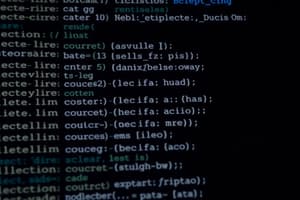Podcast
Questions and Answers
What is the common way to represent a graph in computer science?
What is the common way to represent a graph in computer science?
- Using a tree data structure
- Using a list of vertices and edges
- Using a matrix of adjacencies (correct)
- Using a set of nodes and a set of edges
Which graph traversal algorithm is used to visit all reachable nodes from a given starting node?
Which graph traversal algorithm is used to visit all reachable nodes from a given starting node?
- Dijkstra's algorithm
- Depth-First Search (DFS)
- Breadth-First Search (BFS) (correct)
- Kruskal's algorithm
What is the time complexity of Breadth-First Search (BFS) on a graph with $V$ vertices and $E$ edges?
What is the time complexity of Breadth-First Search (BFS) on a graph with $V$ vertices and $E$ edges?
- $O(E)$
- $O(V + E)$ (correct)
- $O(V)$
- $O(V^2)$
Which graph data structure is used to represent a tree?
Which graph data structure is used to represent a tree?
What is the purpose of Kruskal's algorithm in graph theory?
What is the purpose of Kruskal's algorithm in graph theory?
What topic does the section 'Undirected graph components' in the text fall under?
What topic does the section 'Undirected graph components' in the text fall under?
Which section in the text mentions 'Minimum spanning tree'?
Which section in the text mentions 'Minimum spanning tree'?
In which part of the text would you expect to find information about 'Topological sort'?
In which part of the text would you expect to find information about 'Topological sort'?
Which part of the text discusses 'Jousting' and 'Dot product'?
Which part of the text discusses 'Jousting' and 'Dot product'?
'Longest common subsequence' and 'Knapsack' are topics found in which part of the text?
'Longest common subsequence' and 'Knapsack' are topics found in which part of the text?
'Borrow a book' and 'Levenshtein distance' are mentioned in which part of the text?
'Borrow a book' and 'Levenshtein distance' are mentioned in which part of the text?
What is the purpose of the adjacency matrix representation of a graph?
What is the purpose of the adjacency matrix representation of a graph?
Which graph traversal algorithm is used to visit all reachable nodes from a given starting node?
Which graph traversal algorithm is used to visit all reachable nodes from a given starting node?
What is the purpose of Topological Sort in graph theory?
What is the purpose of Topological Sort in graph theory?
What is the purpose of the adjacency list representation of a graph?
What is the purpose of the adjacency list representation of a graph?
What is the purpose of Kruskal's algorithm in graph theory?
What is the purpose of Kruskal's algorithm in graph theory?
What is the purpose of the edge list representation of a graph?
What is the purpose of the edge list representation of a graph?
What is the most common way to represent a graph in computer science?
What is the most common way to represent a graph in computer science?
Which graph traversal algorithm is used to visit all reachable nodes from a given starting node?
Which graph traversal algorithm is used to visit all reachable nodes from a given starting node?
What is the time complexity of Breadth-First Search (BFS) on a graph with $V$ vertices and $E$ edges?
What is the time complexity of Breadth-First Search (BFS) on a graph with $V$ vertices and $E$ edges?
Which graph data structure is used to represent a tree?
Which graph data structure is used to represent a tree?
What is the purpose of Kruskal's algorithm in graph theory?
What is the purpose of Kruskal's algorithm in graph theory?
What is the purpose of Prim's algorithm in graph theory?
What is the purpose of Prim's algorithm in graph theory?
What is the purpose of Dijkstra's algorithm in graph theory?
What is the purpose of Dijkstra's algorithm in graph theory?
What is the purpose of Topological Sort in graph theory?
What is the purpose of Topological Sort in graph theory?
What is the purpose of the Strongly Connected Components (SCC) algorithm in graph theory?
What is the purpose of the Strongly Connected Components (SCC) algorithm in graph theory?
What is the purpose of the Tarjan's algorithm in graph theory?
What is the purpose of the Tarjan's algorithm in graph theory?
What starts with an empty candidate sequence or set and extends it one item at a time?
What starts with an empty candidate sequence or set and extends it one item at a time?
Which technique only generates a fraction of all candidates making it more efficient than exhaustive search?
Which technique only generates a fraction of all candidates making it more efficient than exhaustive search?
In backtracking, what core traversal is used for generating permutations and subsets?
In backtracking, what core traversal is used for generating permutations and subsets?
When extending a candidate in backtracking, what does the algorithm do if it cannot lead to a solution or a better solution?
When extending a candidate in backtracking, what does the algorithm do if it cannot lead to a solution or a better solution?
At the core of backtracking is a recursive pre-order traversal of what structure?
At the core of backtracking is a recursive pre-order traversal of what structure?
Which problems in M269 are solved using backtracking on sequences of non-duplicate items or subsets of items?
Which problems in M269 are solved using backtracking on sequences of non-duplicate items or subsets of items?
What is the purpose of the first check in a backtracking algorithm?
What is the purpose of the first check in a backtracking algorithm?
What is the purpose of the second check in a backtracking algorithm?
What is the purpose of the second check in a backtracking algorithm?
How can the search space be further pruned for subset problems in a backtracking algorithm?
How can the search space be further pruned for subset problems in a backtracking algorithm?
What is the purpose of the third check in a backtracking algorithm for optimization problems?
What is the purpose of the third check in a backtracking algorithm for optimization problems?
What represents the local constraints in a backtracking algorithm?
What represents the local constraints in a backtracking algorithm?
In the context of backtracking algorithms, what do 'candidates' and 'extensions' represent?
In the context of backtracking algorithms, what do 'candidates' and 'extensions' represent?
What is the primary purpose of backtracking?
What is the primary purpose of backtracking?
Which condition is necessary for backtracking to be applicable?
Which condition is necessary for backtracking to be applicable?
What is the primary advantage of backtracking over exhaustive search?
What is the primary advantage of backtracking over exhaustive search?
What is the primary difference between global constraints and local constraints in backtracking?
What is the primary difference between global constraints and local constraints in backtracking?
In the context of backtracking, what is a partial candidate?
In the context of backtracking, what is a partial candidate?
What is the typical approach used by backtracking algorithms to explore the search space?
What is the typical approach used by backtracking algorithms to explore the search space?
What is the primary advantage of backtracking over exhaustive search?
What is the primary advantage of backtracking over exhaustive search?
What is the primary difference between global constraints and local constraints in backtracking?
What is the primary difference between global constraints and local constraints in backtracking?
When extending a candidate in backtracking, what does the algorithm do if it cannot lead to a solution or a better solution?
When extending a candidate in backtracking, what does the algorithm do if it cannot lead to a solution or a better solution?
How can the search space be further pruned for subset problems in a backtracking algorithm?
How can the search space be further pruned for subset problems in a backtracking algorithm?
What is the purpose of the first check in a backtracking algorithm?
What is the purpose of the first check in a backtracking algorithm?
Which technique only generates a fraction of all candidates, making it more efficient than exhaustive search?
Which technique only generates a fraction of all candidates, making it more efficient than exhaustive search?
What is the primary advantage of backtracking over exhaustive search?
What is the primary advantage of backtracking over exhaustive search?
What do the 'local constraints' represent in the context of a backtracking algorithm?
What do the 'local constraints' represent in the context of a backtracking algorithm?
What is the purpose of the first check in a backtracking algorithm?
What is the purpose of the first check in a backtracking algorithm?
How can the search space be further pruned for subset problems in a backtracking algorithm?
How can the search space be further pruned for subset problems in a backtracking algorithm?
What is the primary difference between global constraints and local constraints in a backtracking algorithm?
What is the primary difference between global constraints and local constraints in a backtracking algorithm?
What is the key ingredient that turns an exhaustive traversal into a backtracking algorithm?
What is the key ingredient that turns an exhaustive traversal into a backtracking algorithm?
What is a key advantage of backtracking over exhaustive search?
What is a key advantage of backtracking over exhaustive search?
In backtracking, where are global constraints checked?
In backtracking, where are global constraints checked?
What differentiates backtracking from brute-force search in terms of candidate generation?
What differentiates backtracking from brute-force search in terms of candidate generation?
How does backtracking handle local constraints during candidate generation?
How does backtracking handle local constraints during candidate generation?
Why is backtracking more efficient than generating all permutations?
Why is backtracking more efficient than generating all permutations?
What is a distinguishing feature of backtracking compared to brute-force search regarding the search space?
What is a distinguishing feature of backtracking compared to brute-force search regarding the search space?
Flashcards are hidden until you start studying




